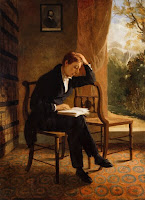My Obligatory Keats Post
 |
| John Keats painted by Joseph Severn, close friend of Keats' |
John Keats died at the age of 25 from tuberculosis, the same disease that claimed the lives of his mother and brother. I often think about how he believed himself to be a failure at the time of his death, having given up his career of being a surgeon to pursue the life of a poet yet never receiving the renown he sought. How must he have felt requesting that his tombstone read, "Here lies one whose name was writ in water"? Though he may have been ready to die, having long contemplated death in the short years of his life, he had aspirations for his work that were never fulfilled. He was not much older than I am now - a haunting thought for another a not-yet accomplished writer.
 |
| Fanny Brawn in 1850, 29 years after Keats' death |
It's difficult to discuss Keats without mentioning his muse and fiancée, Fanny Brawne. He met Fanny after moving in next door to her in Hampstead, and wrote many poems inspired by their love. In July of 1819, he wrote to her: "I have two luxuries to brood over in my walks, your Loveliness and the hour of my death. O that I could have possession of them both in the same minute. I hate the world: it batters too much the wings of my self-will, and would I could take a sweet poison from your lips to send me out of it" (10). Though they only knew each other for a little over two years, their story transcends death and lives on in the many letters and poems crafted by Keats' hand. After he died, Fanny continued to wear her engagement ring until her death in 1865 and never forgot the love they shared. You can now visit Keats' London home and see where he wrote his most well-known masterpieces.
My favorite poem of Keats' is "On Seeing the Elgin Marbles." The Elgin Marbles are Greek statues that used to be at the Parthenon, but now reside in the British Museum (although problematic, it does mean we will have the opportunity to see them while we are in London). Keats wrote this poem after seeing the statues and noting their deterioration, reflecting on mortality and the impermanence of even the marble in front of him. I often recite this poem in my head in times of stress, for the sole comfort of the rhythm and the beauty of his language.
My spirit is too weak—mortality
Weighs heavily on me like unwilling sleep,
And each imagined pinnacle and steep
Of godlike hardship tells me I must die
Like a sick eagle looking at the sky.
Yet ’tis a gentle luxury to weep
That I have not the cloudy winds to keep
Fresh for the opening of the morning’s eye.
Such dim-conceived glories of the brain
Bring round the heart an undescribable feud;
So do these wonders a most dizzy pain,
That mingles Grecian grandeur with the rude
Wasting of old time—with a billowy main—
A sun—a shadow of a magnitude.
Keats, John, and Jane Campion. So Bright and Delicate: Love Letters and Poems of John Keats to Fanny Brawne. Penguin, 2009.



Comments
Post a Comment